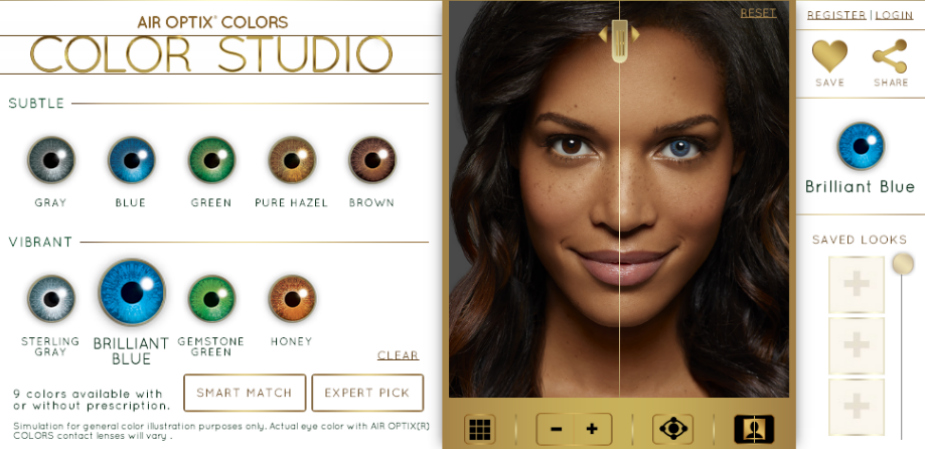

Have you ever wondered what you’d look like if your eyes were a different color? With color contact lenses, you can try out a variety of colors to suit your look and your mood. In fact, you can even virtually try on all of the color options on the AirOptics website http://www.airoptix.com/colors/color-studio.shtml, or download the app. Then, simply upload a photo of yourself and the fun begins!
We really like AirOptics Color Contacts because they have a great selection of colors to choose from and the look is very natural.
Most colored contact lenses are designed to mimic the natural look of the colored part of the eye, called the iris. Since this area is made up of colorful shapes and lines, some color contacts feature a series of tiny colored dots and radially arranged colored lines and shapes to help the lenses look more natural on the eye. The center of the lens, the part that lies over your pupil, is clear so you can see.
Color contacts are available in both prescription and non-prescription forms. The cost of colored contacts can be significantly more than for regular contacts; but for many wearers, the ability to change their eye color is well worth it.
Choosing the Right Color
The contact lens color that will suit you best depends on numerous factors, such as your hair color and skin tone. But, ultimately, it depends on the kind of look you want to achieve — subtle and natural-looking or dramatic and daring. If you want to experiment with a different eye color while still looking natural, you might choose contact lenses in gray or green, for example, if your natural eye color is blue.
If you’re after a dramatic new look that everyone notices immediately, those with naturally light-colored eyes and a cool complexion with blue-red undertones might choose a warm-toned contact lens such as light brown.
Color Contacts for Dark Eyes
Opaque colored tints are the best choice if you have dark eyes. For a natural-looking change, try a lighter honey brown or hazel colored lens. But if you really want to stand out from the crowd, opt for contact lenses in vivid colors, such as blue, green or violet. And if your skin is dark, bright-colored lenses can create a show-stopping new look.
Color Contacts: What You Need to Know
• Although there are different-sized lenses to fit most wearers, there will be some occasions (such
as during blinking) where the colored portion may slide somewhat over the pupil. This creates
a less-than-natural appearance, particularly when wearing opaque color contacts.
• The size of your pupil is constantly changing to accommodate varying light conditions — so
sometimes, like at night, your pupil may be larger than the clear center of the lens. In these
instances, your vision may be affected slightly.
Are Color Contact Lenses Safe?
Yes, colored contact lenses are safe — as long as your contacts are properly prescribed, used and cared for. It’s essential that you visit your eye care professional for a proper contact lens fitting. This will ensure your colored contacts are safe and comfortable and look natural on your eye. Just like regular contact lenses, color contacts are not bad for your eyes if you follow your eye care practitioner’s instructions, particularly regarding how long you can wear your contacts and when you should replace your contacts. If you wear colored contacts only on special occasions, daily disposables are a great option.
Do You Need a Prescription for Color Contact Lenses?
Yes, you need a contact lens prescription to purchase colored contacts legally in the United States. This is true even for plano color lenses that don’t have prescriptive power and are worn for cosmetic purposes only. Always ensure you’re buying contact lenses from a legitimate source; the health and safety of your eyes is not something to play around with!
Color Contacts Do’s and Don’ts
• Don’t share your contact lenses. As fun as it may sound, never swap colors with your
friends. Contact lenses are medical devices and are fitted to the specifications of each
individual’s eyes. Exchanging lenses also can transmit harmful bacteria, which can lead to a
serious, vision-threatening eye infection.
• Care for your contact lenses properly. Color contacts, like clear contact lenses, must be
properly cleaned, disinfected and stored with appropriate lens care products to avoid
contamination. And don’t forget to replace your lenses according to your eye care professional’s
instructions.
• Don’t wear your contacts if you develop sore, irritated or red eyes. This may be a symptom of a contact lens-related eye infection or other serious problem. Contact your eye doctor immediately if you experience discomfort during or after contact lens wear.
• Have fun with your new look! Whether you want to enhance your facial features or create a
dramatic statement, colored contacts allow you to have the eye color you’ve always wanted.
Color contact lenses continue to grow in popularity, and there is an ever-widening variety of colors and effects to choose from. With the help of your eye care practitioner, you can find a colored contact that’s comfortable to wear and best suits your personality and desired appearance.
For more information, or to schedule an appointment,
please call our office at 209.465.5933.




